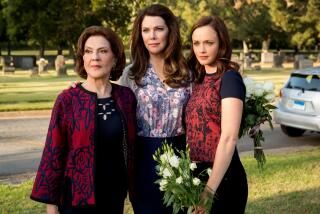Review: Jane Smiley on Geoff Dyer: hard to take but worth the attempt

British writer Geoff Dyer goes west in “White Sands.”
“Stories don’t interest me,” Geoff Dyer told the Huffington Post in 2014. That this is true is evident in his new collection of essays, “White Sands.” Which doesn’t mean that “White Sands” isn’t a good read, because it is. You must, however, get used to Dyer’s tone, which is persnickety and unenthusiastic. His virtue is not the whole-hearted embrace of experience and exotic locales but the parsing of degrees of disappointment. He also doesn’t pretend to be heading anywhere, but then “White Sands” turns into a memoir and becomes unexpectedly moving.
Geoff Dyer, who now teaches nonfiction at USC, is known for “genre demolition” according to the Paris Review; his 2011 collection, “Otherwise Known as the Human Condition: Selected Essays and Reviews,” won that year’s National Book Critics’ Circle Award for Criticism. One of the best essays in the collection is about Dyer’s experiences as an only child born into limited circumstances in Britain in the ‘50s: one cousin, not much access to the great world because of his father’s frugality. He came to cherish books and boredom, something I can sympathize with, as another only child. But if stories don’t interest a writer, then his fallback option is investigating primarily, or only, his own inner life, and this is Dyer’s forte.
My least favorite essay in “White Sands” is the first, “Where? What? Where?,” about Dyer’s trip to Tahiti to research a centennial essay on Paul Gauguin. It is lucky that he is by himself, perhaps, because after he loses his book about Gauguin in LAX, he is exceedingly grumpy — he spends about 250 words making fun of Tahitians for being fat, as in “They stare at you from the depths of their blubber.” I like to think that they were staring at him because they couldn’t figure out why he was unable to crack a smile.
But annoying the reader isn’t a bad way to start a book of essays, especially if you are an English writer — think Oscar Wilde and G.K. Chesterton — and after “Where? What? Where?” Dyer’s paradoxical style becomes more familiar and more amusing.
The essay “Space in Time” is a perfect example of what Dyer has to offer. The scene is an art installation somewhere in the desert, but he waits to reveal where it is (so perhaps you the reader will not look it up on Google Maps). The installation is a grid of poles sunk into the desert. Visitors are restricted to a few at a time and required to stay for a day and a night. The natural world here has an alien feel, which Dyer is good at describing (“The sun was sinking fast and everything began changing fast. The silver poles glowed goldly.”) As darkness gathers, Dyer observes, “We were in the midst of what may once have been considered a variety of religious experience. Absence had given way to presence.” Throughout the essay he describes the feel of the experience first, then the physical details of the artwork; as a result, the progress of the essay mimics the experience of the visit.
Not every travel experience is as successful, and Dyer is maybe more fascinated by pilgrimages that fail to deliver, such as his journey in search of the Northern Lights, than he is by those that do deliver. In his last few essays, the energy continues to mount. His most deeply felt pilgrimage takes him to that capital of intellectual exile (wait for it) — Los Angeles.
Dyer’s Los Angeles quest is not about the homes of the stars or Malibu or traffic or even eternal sunshine. It is about Theodor Adorno, Max Horkheimer, Thomas Mann, Bertolt Brecht and other European philosophers and critics who got to L.A. right around the time James Cagney was filming one of my all-time favorite —- and entirely non-dialectical/existentialist movies — “Yankee Doodle Dandy.” Talk about worlds in collision.
Dyer is a longtime lover of Adorno’s “Minima Moralia: Reflections from a Damaged Life,” which he discovered in the ‘80s (and which he once cited in a “favorite reads” article for the Guardian “partly because I loved it but also to … distinguish myself from novelists who I guessed would choose ‘The Go-Between’ or ‘Tender is the Night’ or whatever.” (No one quite as sneering as a critic, is there?) But his exploration of Adorno’s and Horkheimer’s L.A. lives is witty and enlightening, and it transitions us to the last two essays, “Something Big,” which appeared in Harper’s in April, about jazz and the Watts Towers, and, from “The London Review of Books,” “A Stroke of Good Luck” about Dyer’s own unexpected reckoning, possibly brought on by too many doughnuts.
Since Dyer is good at learning from experience, he is good at learning from this one too: “We then went through the familiar round of tests, at which, without wishing to boast, I had come to excel: hand squeezing, face stroking, finger counting, and so on.” Dyer’s tone as he relates his frightening brush with tragedy is calm and full of curiosity, possibly as a result of eschewing drama for his entire life.
“White Sands” is a short book, brisk, hard to take and worth the attempt, just the sort of paradox Dyer most enjoys.
The third volume of Smiley’s “Last Hundred Years” trilogy was published in the fall.
::
“White Sands”
Geoff Dyer
Pantheon: 256 pp., $25
More to Read
Sign up for our Book Club newsletter
Get the latest news, events and more from the Los Angeles Times Book Club, and help us get L.A. reading and talking.
You may occasionally receive promotional content from the Los Angeles Times.






